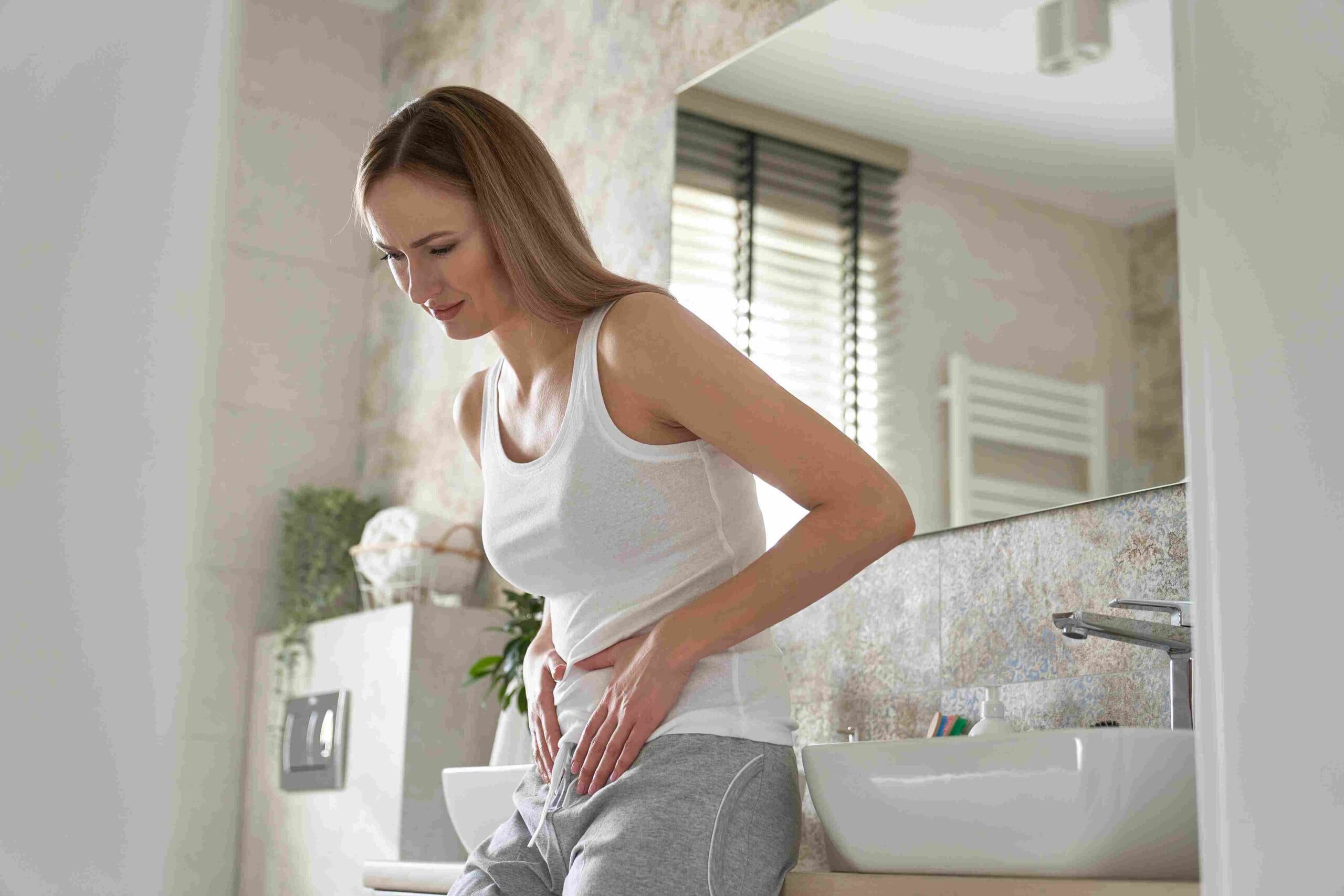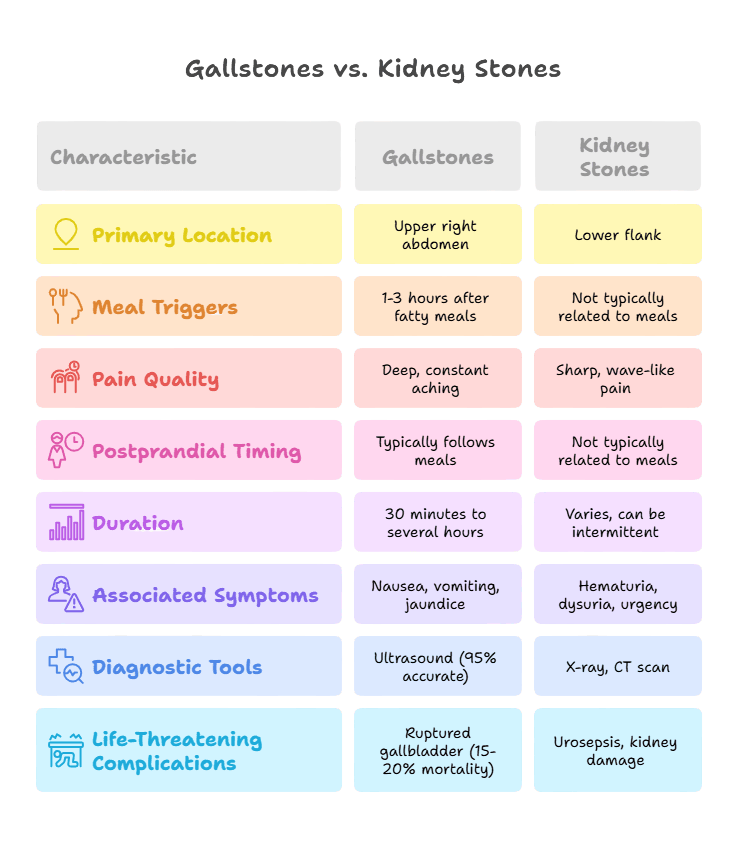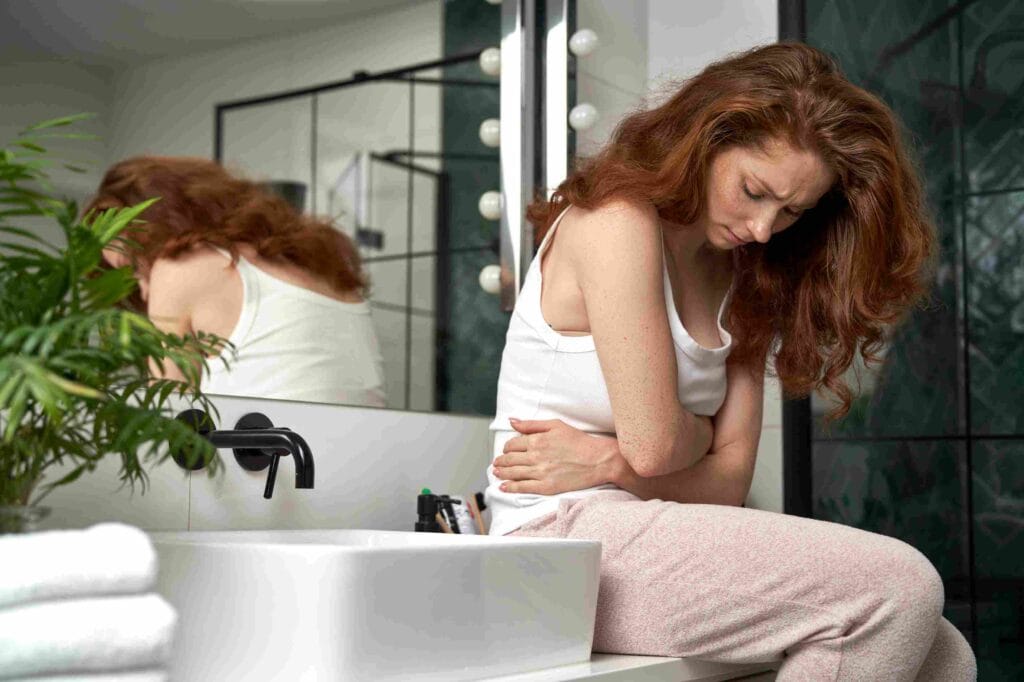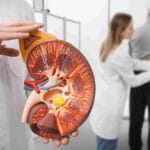
Table of Contents
Introduction: The Agony of the Unknown
What can mimic kidney stone pain? Several serious medical conditions including appendicitis, gallbladder attacks, ovarian cysts, muscle strains, herniated discs, urinary tract infections, and bowel obstructions can produce identical symptoms to kidney stones
Imagine this - you’re bent over in agony, holding your side as waves of pain pulse through both your back and your abdomen. Your first thought? Kidney stones. But here’s the frightening reality that may save you: what appears to be a kidney stone attack might actually be something much more dangerous waiting to erupt.
The truth is intriguing and also scary. Kidney stone pain is famously intense — many patients say it’s worse than childbirth — and it’s a stabbing, moving kind of pain that starts at the back and moves to the front, to the ganyl region. But this unique torment is not confined to kidney stones. Behind these same symptoms, erudite hiders of several life-threatening diseases play in an unimaginable style, tricking patients, and sometimes even experienced patients.
Knowing these medical mimics is not just useful information — it could be life-saving information. When appendicitis masquerades as kidney stone pain, delayed treatment can lead to rupture and life-threatening complications. When ovarian torsion hides behind familiar symptoms, every minute counts to save fertility. The key differences between these conditions can mean the difference between proper treatment and medical emergency.
And this detailed guide will provide you with important information about those kidney stone symptoms you are used to – and then seven of the most important conditions that mimic them perfectly. You will uncover the small warning signs that separates one condition from the other, and the exact time you need to call for professional medical attention. Because when you’re hit with extreme pain, knowing what you’re really dealing with could literally save your life.
Understanding the Signature of Kidney Stone Pain
Kidney stone pain has a certain finger print that is different from the rest of the syndromes but identifying this is important due to different management and disease progression.
The Classic Pain Pattern
The pain of a kidney stone usually starts in a very specific place. The pain is located on one side of the lower back or sides, just below the ribs, according to Keck Medicine of USC. This isn’t one of those diffuse lower back aches – it’s an exact, specific torment that feels like somebody is sticking a knife in your kidney region.
What gives kidney stone pain that special “I don’t want to have it” quality? The sharp feeling begins at your side and your back beneath your ribs and then travels downward like a shock, and it spreads both out to your lower abdomen and down into your testicles or labia. This retrograde movement mirrors the movement of your ureter as the stone seeks its way through your urinary system.
Pain Characteristics That Define the Experience
Intensity and Quality
As anyone who’s ever had a kidney stone can attest, it’s one of the most excruciatingly painful conditions there is. “It’s the worst pain,” and there is no arguing with that.
- Sharp, stabbing sensations
- Intense cramping pain
- Such an internal pressure it hurts
Wave-Like Pattern
Unlike steady pain from, say, a headache or a sore muscle, the discomfort that kidney stones produce tends to come and go in sharp, sudden waves. These excruciating episodes become more severe as the stone travels along your ureter, causing hours of agonizing pain that let up to half hours of some relief.
Accompanying Warning Signs
Kidney stone pain rarely travels alone. Watch for these telltale companions:
- Bleeding in the urine (pink, red, or brown color)
- Constant feeling of nausea and vomiting
- Painful, burning urination
- Fever and chills (as sign of potential infection)
- Urinating frequently, passing only small amounts
The Position Test
One important clue: the pain of a kidney stone is usually unchanged, regardless of your position. Not so with muscle aches and other maladies, this never-ending onslaught from the inside provides no escape or change for the better.
Mimic 1: Urinary Tract Infections (UTIs) – More Than Just Burning.
Kidney stones also can cause a urinary tract infection called pyelonephritis, or “pyelo” for short, which is an infection of the upper urinary system that may go to the bloodstream. This can cause confusion in diagnosis and delay in treatment.
When UTIs Are So Much Worse Pyelonephritis
Pyelonephritis is an infection of the kidneys, most commonly caused by bacteria that moves from the bladder to the kidneys; as many as 250,000 Americans get the condition each year, research published in American Family Physician shows. Once bacteria make their way to your kidneys, they cause severe flank and back pain that makes you feel a lot like you do when you have kidney stones.
The pain usually occurs in the same general area as where you might have had kidney stones – in your upper back and sides, under your ribs. But pyelonephritis causes a duller, more persistent pain than the stabbing, spreading waves that come with kidney stones.
Key Differences That Matter
Pain Characteristics
- UTI/Pyelonephritis: Dull, constant aching pain that’s generally less severe than kidney stones
- Intensity: Cramping sensation rather than sharp, stabbing pain
- Pattern: Steady discomfort without the wave-like intensification of kidney stones
Distinctive UTI Symptoms
UTIs have their own telltale signs:
- Persistent fever and chills (often exceeding 101°F)
- General malaise and feeling unwell
- Cloudy, foul-smelling urine
- Frequent urination with burning sensation
- Blood in urine (shared with kidney stones)
The Diagnostic Key: Urinalysis
The key discriminator is urinalysis. Research indicates that urinary tract infections create telltale markers — white blood cells, bacteria and nitrites — that aren’t associated with kidney stones. Positive urine culture (ascertains a bacterial infection) within 24-48 hours.
Gender Vulnerability
According to research from the Journal of Urology women are at a much greater risk of UTIs and have infection rates 30 times higher than men, thanks to anatomical differences. Female urethra is shorter than males so that bacteria can easily enter into the urinary tract.
Critical Takeaway
Though both conditions exhibit similar overlapping symptoms such as painful urination and blood in urine, the fever, chills, and persistent aching pain of pyelonephritis stand in stark contrast to the intermittent, excruciating waves of kidney stones.
Mimic 2: Appendicitis – The Right-Sided Imposter
Appendicitis, the inflammation of a small, finger-like pouch attached to the large intestine, causes one of the most dangerous kidney stone imposters. This condition affects approximately 1 in 1,000 people annually according to the American Journal of Surgery, making it a critical differential diagnosis that emergency physicians must consider.
The Deceptive Pain Migration Pattern
What makes appendicitis especially treacherous is its changing pain profile. The Lahore-based authors of a paper published recently in The Lancet indicate that classic appendicitis hews to a unique migratory pattern that can at first confuse both patients and health care providers.
It usually starts as a dull pain around your belly button (navel) that becomes sharp as it moves to your lower right abdomen over the period of 12-24 hours which corresponds to McBurney’s point. Nonetheless, 20-30% of cases present with an atypical pain pattern such as flank pain, which may mimic kidney stones.
Key Differences That Save Lives
Pain Characteristics and Movement
- Location Evolution: Starts centrally, then localizes to lower right abdomen
- Movement Response: Unlike kidney stones, movement significantly worsens appendicitis pain
- Quality: Constant, aching pain that progressively intensifies rather than wave-like kidney stone pain.
Distinctive Warning Signs
As Verywell Health explains, the two are often mixed up — understandably so — since both can cause right-sided pain. But appendicitis has its own tell-tale signs:
- Loss of appetite (anorexia) – often the first symptom
- Sequential symptom pattern: Appetite loss → abdominal pain → nausea/vomiting → fever
- Low-grade fever (99-102°F) developing after pain onset
- Rebound tenderness when pressure is released from the abdomen
The Critical Timeline
In a publication in Emergency Medicine Clinics, it’s shown that undiagnosed appendicitis can perforate in 48-72 hours and the mortality rate goes from less than 1% to 5-15% after rupture
Diagnostic Distinction
While kidney stones cause urinary symptoms and flank-to-groin radiation, appendicitis creates gastrointestinal distress with right-sided abdominal focus. The absence of urinary symptoms combined with gastrointestinal signs strongly suggests appendicitis over kidney stones.
Bottom line: When right-sided pain involves appetite loss and worsens with movement, appendicitis becomes the prime suspect requiring immediate medical evaluation

Mimic 3: Gallstones and Gallbladder Problems – Upper Abdomen vs. Flank
More than 25 million adults in America suffer with gallbladder disease, and gallstones are the number one cause of ER visits for severe abdominal pain that mimics renal colic from kidney stone attacks. Gallstone-linked pain sends almost 750,000 people to American emergency rooms every year, says research recently published in the American Journal of Gastroenterology causing frequent diagnostic confusion with kidney stones.
Pain Patterns of Gallstones
Gallstones cause what doctors refer to as “biliary colic” — severe pain as stones block the flow of bile. Researches posted to Gastroenterology Research and Practice indicate that this pain tends to be felt in the upper right side of the abdomen or the area towards the right side just below the rib cage.
The pain can also spread out significantly, spreading to the back – especially between the shoulder blades and also towards the right shoulder tip. This radiation is due to the fact that the gallbladder has the same nerve pathways as these locations, and it causes referred pain, which in fact may make the clinical picture confusing.
Key Differences That Matter
Location and Triggers
- Primary Location: Upper right abdomen vs. kidney stones’ lower flank pain
- Meal Triggers: Research shows 80% of gallbladder attacks occur 1-3 hours after consuming fatty or greasy meals
- Pain Quality: Deep, constant aching rather than kidney stones’ sharp, wave-like painDistinctive Patterns
Distinctive Patterns
The following is reported in studies published in clinical Gastroenterology and Hepatology, Gallbladder-related Symptoms:
- Postprandial timing: Pain typically follows meals, especially high-fat content
- Duration: Episodes last 30 minutes to several hours
- Associated symptoms: Nausea, vomiting, and sometimes jaundice
Critical Diagnostic Tools
Ultrasound is considered the gold standard for diagnosis of gallstones and is 95% accurate, according to Radiology journal research. This test is a fast, noninvasive way to distinguish gallstones from kidney stones, based on what the stones actually look like.
Life-Threatening Complications
Ruptured gallbladder is a surgical emergency with mortality up to 15-20% if untreated, as reported in Studies In Surgery journal. Warning signs include:
- Sudden, severe upper abdominal pain
- High fever and chills
- Rigid abdominal muscles
- Signs of shock
Bottom line: Although the pain of both conditions is substantial, the gallbladder issues remain more in the upper abdomen, tend to come and go with meals and must be confirmed with an ultrasound. There Is always a cause to pain in this area when there is rapid onset of upper abdominal pain after a fatty meal — think about the gallbladder.
Mimic 4: Musculoskeletal Back Pain – When Pain Doesn’t Move
Up to 80 percent of adults will experience a back injury at some point in their lives, the American Physical Therapy Association reports. Of these latter, muscle strains, ligament sprains, and disk herniation often produce lower back symptoms which can simulate renal colic and thus cause diagnostic dilemma in emergencies.
Common Culprits Behind the Pain
Spine Journal published a study that found the most common musculoskeletal lower back pain presentations that mimic kidney stones:
Primary Conditions
- Muscle strains: Overstretching or tearing of the muscle fibers from lifting, twisting, or sudden movements
- Ligament sprain: Injured tissue that supports spinal joints
- Herniated discs: Spinal discs that have ruptured and are pressing on nearby nerves
- Facet joint mechanics: Swollen joints that connect the bones of the spine
Studies show that herniated discs alone affect 2% of the population annually, with peak incidence occurring between ages 30-50
Key Differences That Reveal the Truth
Response to Movement and Position
Differences of pain to movement are the most expressive. According to a study published in Clinical Biomechanics, musculoskeletal pain:
- Worsens with specific movements: Bending, twisting, or lifting
- Improves with position changes: Finding relief when lying down or sitting
- Varies with activity level: Better with rest, worse with exertion
In stark contrast, kidney stone pain remains relentlessly constant regardless of position changes
Missing Kidney Stone Symptoms
Clinical studies in the Journal of Emergency Medicine The symptoms of musculoskeletal diseases are different from stone diseases.
- No urinary symptoms: Discontinuance of pain during urination, passage of blood in the urine or frequent desire of prolonged urination
- No systemic symptoms: Absence of nausea, vomiting, or fever
- No radiation: Pain does not spread, it remains in the same area, it does not shoot to the groin.
Diagnostic Clarity Through Examination
According to Physical Medicine and Rehabilitation (PMR) studies, the clinical examination is able to easily differentiate between the two. Healthcare providers assess:
- Range of motion testing: Limited movement with musculoskeletal issues
- Palpation findings: Muscle spasms or trigger points
- Neurological testing: Nerve involvement with disc problems
Bottom Line: If back pain is positional and does not have urinary symptoms, musculoskeletal etiologies are more likely and different treatments completely are needed for them than for kidney stones.
Mimic 5: Gynaecology (for Women) – Pain in the Pelvis.
Women seem to be uniquely susceptible to challenging diagnoses of severe abdominal pains, simply because a number of gynecological problems can look exactly like kidney stones. American Journal of Emergency Medicine research reveals that as many as 20% of women who are thought to have kidney stones actually have gynecological conditions contributing to their symptoms.
The Puzzle of Women’s Pain
Conditions That Mimic Kidney Stone Symptoms “There are other things that can cause pain in the back or the flank,” which manifest as symptoms similar to those of kidney stones, continues Dr. Eisner. Studies in Obstetrics & Gynecology describe several conditions as giving kidney stone-like symptoms, especially if the stones are lower down the ureter near the bladder:
Primary Gynecological Mimics
- Ovarian cysts: Fluid-filled sacs that can rupture or twist, with 8 percent of premenopausal women affected each year
- Endometriosis: Pathologically displaced uterine tissue causes pain in 10-15% of reproductive-aged women
- PID (Pelvic Inflammatory Disease): Infection in 5% of sexually active women under 25.errorMessage.346mini.slfPID (Pelvic Inflammatory Disease): Infection in 5% of sexually active women under 25.errorMessage.346mini.
- Torsion of the ovary: An emergency that only affects 3% of the population each year and necessitates surgical intervention at once
Key Differences That Guide Diagnosis
Menstrual Cycle Connections
With this in mind, the following study published in Gynecologic and Obstetric Investigation found some patterns in timing:
- Ovarian cysts: Pain is usually most intense during the middle of the menstrual cycle (ovulation) or during a woman’s menstrual period
- Endometriosis: Doesn’t cycle well (pain during vs post menses)
- Functional cysts: Symptoms tend to disappear within 1 to 3 menstrual cycles; palliative therapy may be indicated in some cases.
Genital Signs and Symptoms
Clinical evidence suggests that these conditions have distinctive warnings signs, not shared with kidney stones:
- Abnormal vaginal discharge: Discharge that is yellow-green and smells bad with PID
- Abnormal bleeding: Between-period spotting or significant menstrual flow
- Painful sex: A symptom unceremoniously known as Dyspareunia (painful intercourse) frequent in cases of endometriosis and PID
Expert Medical Insight
North Pointe OB/GYN recognizes the significance of these differences when providing care for women. Their studies show that the rates of misdiagnosis fall sharply when health comporollos9are providers take menstrual histories and include pelvic examinations.
Diagnostic Approach
Emergency Medicine Clinics of North America recommends:
- Menstrual history: Onset, flow character and association with pain.
- Pelvic examination: Important for identifying masses, tenderness, and discharge
- Transvaginal ultrasound: 95% sensitive for ovarian pathology
Bottom Line: When abdominal pain is severe and is associated with the menstrual cycle, and when discharge or sexual issues are evident, gynecological causes must replace urological workup as the focus and the woman should be evaluated accordingly.
Critical Mimics: Life-Threatening Emergencies Must Not Miss
Some of the entities that can masquerade as kidney stone pain are truly medical catastrophes where minutes count the difference between life and death. These rare yet lethal mimickers require prompt recognition and emergency intervention.
Ruptured Abdominal Aortic Aneurysm (AAA): The Great Impostor
AAA rupture is among the most life-threatening kidney stone mimics, and if missed, has a greater than 80% mortality rate. is extremely variable and can be a chameleon for emergency physicians.”14 The safety of attempting helium aspiration at the bedside in this clinical scenario is not guaranteed.
Deadly Warning Signs
- Classic triad: Severe back or flank pain, hypotension, and pulsating abdominal mass
- Atypical presentations: Up to 50% of cases don’t show all classic symptoms
- Pain character: Sudden, tearing sensation in the back, abdomen, or flank
- Shock signs: Rapid pulse, dropping blood pressure, pallor, and confusionCritical Action Required
Critical Action Required
Stat Pearls insists on immediate vascular surgeon consultation for suspected AAA rupture. Even a minute of delay has civilian casualties every 20 minutes. CT angiography is the diagnostic modality of choice; Patients who are unstable may need to be taken to the operating table based on clinical suspicion alone.
Retroperitoneal Hematoma: Hidden Bleeding Crisis.
This is a life-threatening situation in which blood is found behind the cavity of the abdomen and causes intense back and flank pain, that can perfectly mimic kidney stone pain. They are caused by trauma, anticoagulation errors or spontaneous bleeding in coagulopathic patients.
Recognition Patterns
- Site of pain: Severe, persistent back or flank pain
- Related symptoms: Signs of blood loss such as weakness, dizziness, falling blood pressure
- Risk Factors: Recent injury, anti-coagulation therapy, or known bleeding disorder
The Emergency Imperative
Though such conditions are rare, they illustrate an important principle: severe, acute pain that comes on quickly with dizziness, weakness or evidence of shock requires emergency evaluation. When hemodynamic instability accompanies kidney stone pain, these potentially fatal mimics should be quickly ruled out with targeted imaging and specialist intervention.
Bottom Line: Trust your gut – if something feels disastrously wrong, it just might be.

Other Internal Organ Causes with Pain that May Overlap
Pain patterns resulting from a number of visceral disease conditions overlap significantly with those of kidney stones, and accurate diagnosis is difficult without appropriate medical evaluation and testing.
Pancreatitis: The Upper Abdominal Deceiver
Pancreatitis, an inflammation of the pancreas, strikes an estimated 275,000 Americans each year, according to the American Gastroenterological Association. This condition causes acut pain in the upper abdomen, which can be as strong as the pain from a kidney stone and frequently cause diagnosis confusion.
Pain Characteristics
- Location: Severe upper abdominal pain that radiates straight through to the back
- Intensity: Often described as excruciating, similar to kidney stone severity
- Pattern: Constant, boring pain that worsens when lying flat
- Triggers: Frequently follows alcohol consumption or large, fatty mealsDistinctive Features
Distinctive Features
Unlike kidney stones, pancreatitis is associated with:
- Nausea and vomiting: More persistent and severe
- Abdominal tenderness: Upper abdomen feels rigid or guarded
- Position preference: Patients often lean forward or curl up for relief Diagnostic Differentiation
Diagnostic Differentiation
Blood tests for enzymes are important when diagnosing:
- Elevated lipase levels: 3x normal values indicate pancreatitis
- Amylase elevation: Supporting evidence for pancreatic inflammation
- CT imaging: Shows pancreatic swelling and complications
Kidney Cancer: The Silent Mimic
Kidney cancer is not as common as kidney stones, but the symptoms can look the same. According to studies conducted by the Journal of Urology, renal cell carcinoma impacts 76,000 Americans each year.
Overlapping Symptoms
- Flank pain: Lower back pain may be similar to pain from kidney stones
- Hematuria: The presence of blood in the urine – common among kidney stones
- Abdominal mass: Palpate during examination if available.
Critical Differences
- Quality of pain: Most often duller, but more constant than kidney stone pain; aggravated by movement, certain foods or foodborne pathogens or chemicals that irritate the stomach and intestines.
- General symptoms: Loss of weight, weakness, constant fever
- Progressive versus paroxysmal: the former term has to do with the nature of the symptoms, but the latter has to do with the nature of the attacks
Diagnostic Importance
Research indicates a possible association of kidney stone history with greater risk for renal cancer, so appropriate workup is essential. Complete testing that involves blood work, advanced imaging (either CT or MRI), and a pointed medical history is critical to correctly diagnose and treat the problems.
The Doctor’s Toolkit: How Diagnosis Provides Clarity
Because the symptoms of kidney stones and their deadly lookalikes so closely mirror one another, physicians rely on advanced testing to help separate the diseases which appear identical — yet call for entirely different treatments. That kind of diagnostic accuracy can literally be the difference between a life-saving intervention and a life-crushing misdiagnosis.
Imaging methods — the mainstay for diagnosis — have their own particular benefits for various clinical scenarios. Ultrasound is an excellent initial tool because it’s completely non-invasive, your doctor can do one in the office, and it’s very good at picking up stones and checking for harmful obstructions in the urinary system. But CT has become the imaging the modality of choice for assessment of kidney stones, particularly when patients are hemodynamically stable and able to undergo the examination.
Such advanced scans can pick up kidney stones anywhere in the urinary system, including tiny stones that other imaging could miss, and it can assess the stone’s location, size and whether complications such as infection or obstruction are present. X-rays and MRI can both assume kidney stones too, depending on the clinically available data and patient variables.
There is also key complementary information that laboratory investigation can provide, and that imaging cannot identify alone. The urinary testing serves as the initial diagnostic tool to press for blood in the urine, signs of infection, or an apparent increase in the stone-forming minerals pointing to active stone disease.
Blood samples help provide further insights by evaluating kidney function through the measurement of both creatinine and blood urea nitrogen, as well as assessing mineral levels, such as those of calcium, phosphorus, and uric acid, which may indicate systemic disturbances that could place patients at risk for forming stones.
This systematic diagnostic strategy allows for the safe and timely discrimination between kidney stones and their life-threatening mimics, which results in life-saving treatment choices and averting debilitating consequences from delayed or mistaken diagnosis.
When to Contact Your Doctor Immediately: Warning Signs
Severe pain should never be ignored or dismissed as something that will resolve on its own, particularly when it involves the intense, debilitating discomfort characteristic of kidney stone-like symptoms. The challenge lies in recognizing when pain crosses the threshold from manageable discomfort to medical emergency requiring immediate professional intervention
A few certain red flag symptoms need attention right away and a trip to the ER or a call to emergency services. An extremely strong pain which appears all of a sudden without any warning is an emergency sign, particularly when this is counter to all efforts of resting, changing your position or intake of some over-the-counter pain-killer. Unrelenting, persistent pain of this nature usually indicates a serious underlying problem that needs to be diagnosed and treated urgently.
Pain with fever and chills is an especially dangerous mix that APPEARS to be infected and is apt to turn life-threatening pretty darned quick, if not addressed. Sepsis and other disastrous complications can be prevented only if body pain along with systemic infection warnings are evaluated at once.
Yet another important red flag is pain that is so intense that it disrupts the way you function or attempt to engage in normal activities. If the pain is advanced to the point that you cannot work, sleep, or do basic daily tasks, then you’ve entered the medical emergency zone that requires professional evaluation.
Most importantly, any type of flank or back pain and some area of dizziness or lightheadedness or signs of shock are a direct medical emergency. All these signs and symptoms together may point to life-threatening conditions, such as rupture of an abdominal aortic aneurysm, in which time is of the essence in order to avoid delay, as with every passing minute, the risk of mortality is very high.
Constant nausea and vomiting with severe pain should also be evaluated immediately, this can be a sign of life-threatening complications or conditions that require immediate treatment. However, a combination of several of these red flags simultaneously multiplies the need for a medical visit by the hour and can even be the difference between life and death.
Experience relief with FemiPro! Our unique formula supports a healthy urinary microbiome, targeting harmful bacteria that cause unwanted leaks. Boost beneficial bacteria for better bladder control and improve urinary health today!

Conclusion: The only Getting Checked is the Best Guess!
The harsh truth is that there are dozens of severe medical conditions that can accurately mimic the pain of kidney stones, leading to a dangerous labyrinth of diagnostic uncertainty that in this case makes attempting to diagnose yourself not just a bad idea, but a literally lethal one. From urinary tract infections to appendicitis to gallbladder and musculoskeletal issues to gynecologic problems, kidney stones have a wide-ranging list of differential diagnoses that harkens back to almost every major organ system in your body.
For that matter, so does a ruptured abdominal aortic aneurysm. There are vastly different treatment methods for each, and mistaking one for the other may delay vital interventions — or send you off on the wrong type of treatment plan entirely.
What comes to looks like a routine kidney stone attack, could rather be appendicitis for which one needs an emergency surgery; gallbladder attack for which you would require emergency assistance or worse a vascular emergency, where the time is ticking away. The latter fact conditions the overlap in clinical manifestations of the two diseases, making it impossible even for very expert emergency physicians not to use extensively of advanced imaging, laboratory and clinical patient assessment for correct diagnosis.
Disease distinction can only be made by a healthcare professional adequately trained in dyspnoea, with experience of these pathologies, who solicits the necessary medical history, undertakes the right physical examination, and orders the relevant investigations. The risks are just too great to leave it to internet searches, symptom checkers or well-intentioned input from friends and family when you are confronted with severe abdominal or back pain.
If you have any signs of severe or concerning abdominal or back pain, contact your healthcare provider to find out the cause and receive the right treatment. Your life and even your health are at stake, based upon an accurate diagnosis and timely intervention.
If you are interested in maintaining great health on your urinary system, they found something very interesting that we think you will love and can easily incorporate it to your day to day use. If you are interested in natural methods to support healthy urinary system function, feel free to visit FemiPro for information that may assist you on your healthcare journey and contribute to your overall well-being.







This Post Has 2 Comments
Kidney stones are no joke, and the pain they cause is something I wouldn’t wish on anyone. It’s fascinating yet terrifying how similar symptoms can mask life-threatening conditions like appendicitis or ovarian torsion. This guide is a wake-up call to pay attention to the subtle differences in pain and symptoms. I wonder, though, how often people actually mistake these conditions for kidney stones in real life? The idea of delayed treatment leading to serious complications is genuinely scary. Do you think there’s enough awareness about these medical mimics? I’d love to hear your thoughts or experiences with this—have you or someone you know ever faced a situation like this?
It is not unusual for people to confuse these disorders with kidney stones, since the symptoms can be similar, including severe abdominal or back pain. But its timing may differ depending on the state of your health. Some people may think that they have a stomach bug, a urinary tract infection or, in the worst case, appendicitis. Medical tests (e.g., imaging, urinalysis) can be useful in diagnosis because these conditions can appear similar, and not all require the same treatment. As always, consult a healthcare practitioner for appropriate evaluation.
However, knowledge about alternative diagnoses associated with kidney stone pain is often limited. They may not realize that there are a lot of other things those symptoms can signify, things that can be treated contientiously, misdiagnosed or shelved.s. Greater awareness about this issue and better access to health information might make people less likely to confuse kidney stones with everything else. Creating awareness can help in early diagnose and treatment which is associated with better health outcomes.